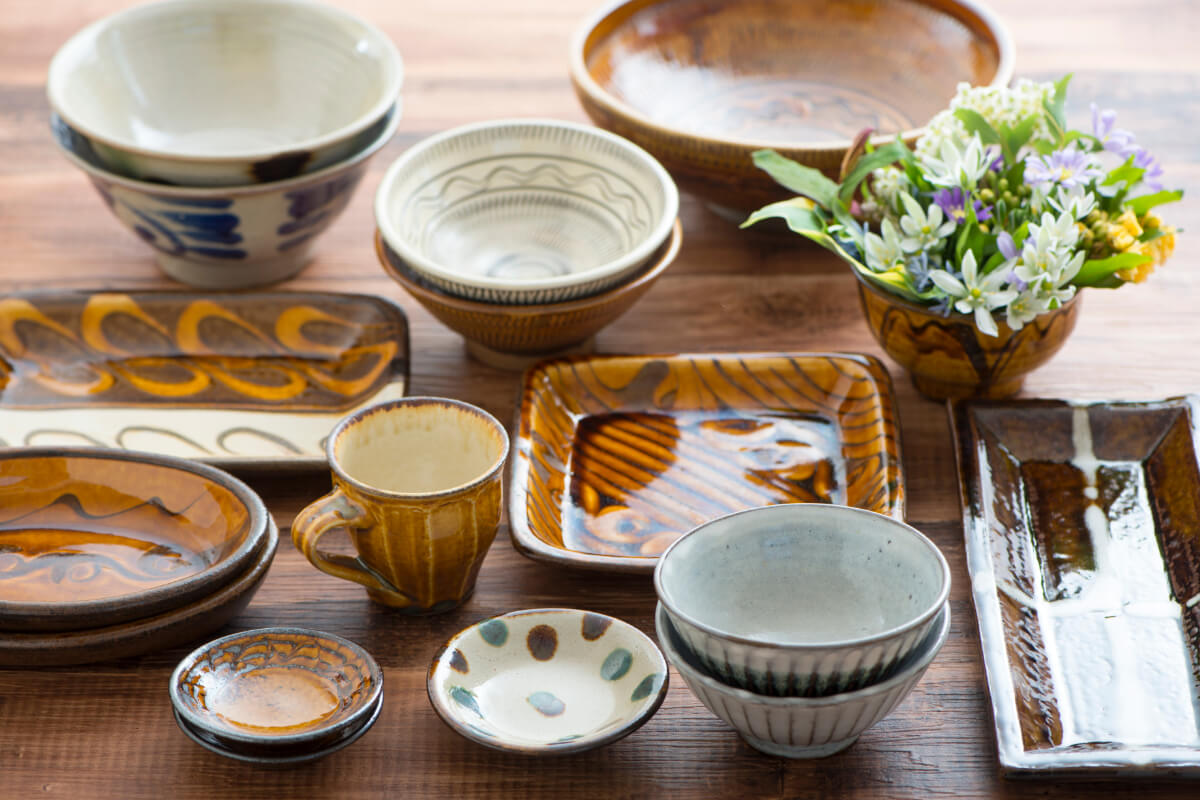その他の産地

栃木県・益子焼(ましこ-やき)
民芸陶器の一大産地
益子焼は、江戸末期、笠間の近くで生まれた大塚啓三郎が笠間の久野窯で技法を学び、やがて益子に甕やすり鉢、土瓶などの台所用品を焼く窯を開いたことから始まります。東京が近いということで、日用雑器の需要が急激に高まった益子焼ですが、金属器の普及などで、明治後期頃から次第に衰退してきました。これを救ったのが”民芸運動”創始者の一人、浜田庄司。日頃、下手ものと言って軽視されがちだった、庶民のための手作りの日用品を見直そうというものです。浜田焼と言ってもよいほど、彼の民芸思想をしっかり継承している益子焼。民芸陶器の故郷・益子は、こうして誕生したのです。
茨城県・笠間焼(かさま-やき)
十人十色の個性の共存
益子と並ぶ関東のやきもの産地・笠間は、江戸時代から甕、すり鉢の産地として知られてきました。手作りならではの温かみある趣に、益子焼と比較されることが多い笠間焼きですが、もともとは笠間が益子のルーツです。昭和初期までに、甕類の一大産地だった笠間が、益子に根をおろした民芸運動の隆盛とともに、工芸品としてのやきものを作るようになります。この伝統へのこだわりのない笠間に“自由”を求めて全国からたくさんの陶工が集まりました。そのせいか、独創性やデザインの斬新さなど、多彩な個性が見られるのが特徴です。
笠間焼協同組合: http://www.kasamayaki.or.jp/
京都府・丹波立杭焼(たんばたちくい-やき)
自然釉の深い味わいが魅力
野放図で素朴さが特徴の丹波立杭焼。現在では、重厚な土肌を薪の灰がかかった自然釉の灰かむりのほか、白丹波や絵のあるものも多くなっています。もともとは、壺、甕、すり鉢、徳利など自然釉の日用品が主に作られていましたが、しだいに茶人小堀遠州の好みに合った灰や赤土部のかかった茶陶へと変わってきたということです。土は立杭周辺の鉄分の多い赤土を使用しますが、白泥をかけた白丹波が作られるようになり、文様も筒描(イッチン)、櫛目、縦じま文様のしのぎ、墨流し、と年々多様になっていきます。また、古丹波には木の葉を押し付けた貼付文なども見られ、深い味わいをかもしだすやきものです。
岡山県・備前焼(びぜん-やき)
やきものとして最古の形式の焼きしめ陶・備前
まさにやきものの町にふさわしく、JR赤保線の伊部駅そのものが備前焼伝統産業館。ホームを出るとすぐ備前焼の世界へ誘ってくれます。この産業館には、観光案内センター、備前焼の展示即売、窯元紹介研修室などの施設が揃っているので、観光前に備前焼のアウトラインをつかむため、また、観光後のおさらいをするために、ぜひ立ち寄りたいところです。備前には、多数の有名窯元や作家が点在していて、中には見学や作陶も可能なところがあるのでぜひ訪ねてみたい。どの窯元でも自社製品を展示即売しているので、窯元めぐりをしながら買い物ができます。また、備前市やその周辺に点在する旧跡、史跡、窯元見学の日帰り定期観光バスが出ているので、やきものファン以外の人も楽しめそうです。
山口県・萩焼(はぎ-やき)
高麗茶碗の面影残す伝統の萩焼
山陰の小京都と呼ばれる萩は、日本海に面した風光明媚な地です。風情のある町並みは今なお、毛利氏の城下町として栄えた時代の面影を色濃くとどめ、武家屋敷や白壁、土塀など、風情ある風景が落ち着いた佇まいを見せています。また、萩は幕末から維新にかけて大活躍した、吉田松陰、高杉晋作、伊藤博文の故郷でもあり、彼らのゆかりの史跡が各所に点在しています。
愛媛県・砥部焼(とべ-やき)
磁器ながら、陶器に近い素朴な味わい
開発期の大洲藩時代、良質の釉薬に恵まれず、何回もの試行錯誤を繰り返して誕生した砥部焼。今や、四国随一のやきものに成長しました。丈夫で、ややぽってりと厚手というのが砥部焼の特徴ですが、これは砥部が豊富な陶石に恵まれていたから。おかげで、陶工たちは原料の心配をすることなく、作陶に励めたと言います。砥部焼のもうひとつの特徴である、白磁に藍色の呉須で描かれたぬくもりのある絵付。この手描きの温かさが、昭和40年代の民芸ブームにのって注目を浴び、国の伝統的工芸品の指定を受けました
福岡県・小石原焼(こいしわら-やき)
九州の名高い民陶
小石原では、英彦山権現に納める器を作っていたと伝えられていますが、1682年、黒田藩3代目藩主光之が伊万里の陶工を招いて、筑豊最初の窯として開かせたのが始まりとされています。昔は半陶半農で、9窯元の世襲制で、2男、3男は陶工として働き、共同の2つの登り窯で壺や甕などの大物を焼いていました。それが現在のような小物づくりを手がけるようになったのは、民芸運動の推進者バーナード・リーチや浜田庄司が小石原を訪れ、その素朴な用美を絶賛したことによります。飛鉋(とびかんな)、刷毛目(はけめ)、櫛描(くしがき)、指描(ゆびかき)、流し掛け、打ち掛けなど、小石原独特の手法は、世界の工芸展で賞をとったり、通商産業大臣の伝統的工芸品に指定されています。
福岡県・上野焼(あがの-やき)
唐津の影響を濃く受けた、侘びの茶陶
茶陶を中心に発展した上野焼の故郷は、福岡県のほぼ中央、田川郡赤池です。やはり、朝鮮半島からの流れで、加藤清正に従って渡来し、唐津で陶業を営んでいた尊楷を豊前小倉藩主・細川三斎忠興が小倉城下に招き、茶器を作らせました。これは九州の窯の中でも特別格調高い作品だったそうです。上野焼という名は、当時尊楷が名のっていた上野喜蔵高国という日本名からきています。細川三斎、小堀遠州ら当時の大茶人の影響を受けることが多く、とくに遠州好みの茶陶を中心に発展してきたので、九州の他の陶磁器に比べると、薄手で軽いのが特徴です。茶陶から発展し、茶道具や鑑賞陶が多く、遠州七窯のひとつに数えられています。
沖縄県・壺屋焼(つぼや-やき)
南国らしい色彩鮮やかな琉球陶芸
沖縄の代表的なやきものと言えば、魔除けの獅子(シーサー)に代表される、南国らしい華やかな色づかいが特徴の壺屋焼です。この壺屋焼は、約300年の歴史をもち、17世紀後半に琉球王府の指導で、各地に点在していた三窯を壺屋の地に統合したのが始まりと言われています。現在の壺屋焼の主流である「上焼」は、朝鮮、中国はじめ薩摩から伝来したもので、沖縄の生活や環境と深くかかわりながら、沖縄独特のやきものが焼かれるようになりました。白釉、黒釉、琉球青磁、飴釉、呉須など、多彩な釉薬も壺屋独特のものですが、とくにサンゴ礁を焼いてつくる石灰とモミがらとを混焼して“白釉もと”を使用するのは沖縄ならではのことです。
